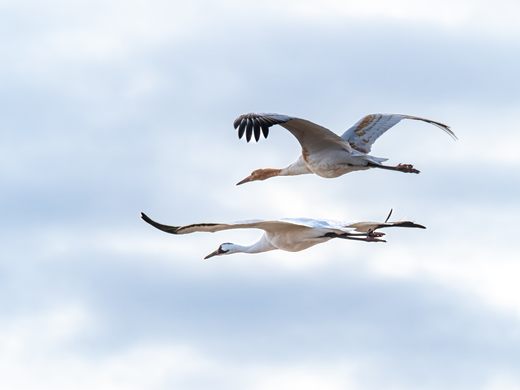AO Edited
Iain Nicolson Audubon Center at Rowe Sanctuary
For one month, the fields and skies of Gibbon, Nebraska, come alive with one of the largest gatherings of sandhill cranes in North America.
The Platte River winds over 300 miles through mountainous wilds, high plains, and cityscapes. But through Nebraska, the Platte River offers more than just its beauty. It offers an annual rest stop for a flock of weary travelers. Each year, along the river banks, nearly a million sandhill cranes make their way to the state. From the Iain Nicolson Audubon Center at Rowe Sanctuary in Gibbon, visitors can see the birds on their yearly northern migration stopover. “These tiny little specks of pepper in the sky will emerge,” Rowe Sanctuary director Bill Taddicken, told the New York Times in 2017. “And then they’ll drop down, become cranes, and they’re here.”
Corn is a big deal in Nebraska, and not just for people—the crop is part of why these birds are attracted to the area. The remains of the season’s corn harvest in fields across the state, provide the sustenance the birds need to make their way north to their nesting grounds in Alaska, Canada, and eastern Siberia. The leftover kernels make up about 90 percent of the birds’ diet, giving the cranes enough food to continue their long journey. It’s estimated that the birds eat around 1,600 tons of corn during their stay. The birds typically stay in the area for about a month, giving visitors lots of opportunities to view these spectacular animals.
While the sight of nearly a million birds is something all by itself, the individual crane is something of a marvel, too. Cranes are one of the oldest species of bird on Earth. According to the Nebraska Game and Parks Commission, “Fossil records place sandhill cranes in Nebraska more than 9 million years ago,” so looking at them is like taking a peek into the prehistoric. They are also impressively sized, standing over three feet tall with a 5.9- to 6.5-foot (1.8 to 2.0 meters) wingspan.
Oh, and they dance. In addition to the like-clockwork arrival in the area each year, the sandhill cranes are also known for their dance-like mating ritual.
The whole purpose of this cross-continental voyage is to make it to the nesting grounds, and before there’s nesting, there’s got to be mating. The cranes engage in an elaborate mating ritual. As Nebraska Game and Parks Commission explains, “Pairs engage in elaborate bowing displays with outstretched wings and leap high into the air. Often, a corncob or stick is picked up and thrown upward repeatedly.” And because cranes usually mate for life, it has got to be a really good dance. But trust the cranes to get it right. You don’t make it 9 million years without some skill.
The Rowe Sanctuary is a perfect spot for those hoping to catch a glimpse of the birds before they take off for the north. The sanctuary offers guided tours and viewing blind rentals, including overnight stays.
Though the sandhill cranes attract a crowd, the sanctuary is home to hundreds of other bird species, including woodpeckers, whooping cranes, and bald eagles, making it a year-round attraction. Visitors can spot these other sanctuary dwellers along the center’s two trails, which offer views of the river, the prairie, and woodlands.
Know Before You Go
The visitor’s center is open Monday-Friday from 9 a.m. - 5 p.m., and admission is free. Crane season generally runs from mid-February until mid-April, and the Sanctuary has extended hours during that period. There are three miles of hiking trails on site, which are open from dawn to dusk, except during crane season when some trails will have limited access to protect the birds.
Guided tours are available during crane season, and reservations are required.













Follow us on Twitter to get the latest on the world's hidden wonders.
Like us on Facebook to get the latest on the world's hidden wonders.
Follow us on Twitter Like us on Facebook